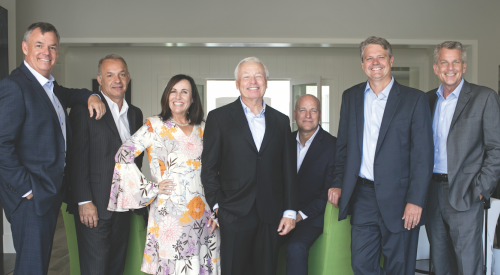|
CEO Larry Webb sets the bar high with a simple credo: Do the right thing.
"We put a lot of emphasis on customer satisfaction measurement," Webb says. "Our incentives revolve around making those customer satisfaction scores. How do you do that? It's not brain surgery. You build the house right the first time. You don't move people into houses that are not ready. When things go wrong, which they will, you fix it the right way, fast. And you treat people with respect and dignity, like you care about them."
No excuses are accepted, especially for delivering incomplete houses.
Dick Bryan, 60, Laing's customer service vice president, sets the corporate benchmark on how to treat customers. He has almost legendary status in the company. "Dick is in the field 4 1/2 days a week," Webb reports. "He's got 300 suits and probably 700 ties. He loves clothes. He's out there knocking on our customers' doors every day looking like that. His whole idea is that if you want people to take you seriously, you need to look serious. And he does.
"Guys who used to work for Dick now head customer service in all of our divisions. And whenever Dick promotes one of his guys, he gives him three or four suits, white shirts and ties out of his own collection. None of them are offended by this. They take it as a sign of love.
"Dick Bryan has a very simple standard for starting off with buyers on the right foot: houses that are complete and clean at closing."
Asked if he ever knowingly closes incomplete houses, Webb replies, "I closed 12 in December 1997 at a project called Springfield. Dick and I knew they weren't ready, but we were trying to make a year. Dick went door to door and gave the customers checks for their January mortgage payments. We had the houses all done by January 5.
"We've had a handful of occasions when divisions did it. But home readiness is something I won't compromise on. We watch them like hawks, and they watch each other. We share all the data in this company, so everyone knows where the problems are. If a division has a problem, the top ones in that category share methods and insight with the division in trouble. They learn pretty fast how to get the houses done."
Flat Organization Chart
Laing's organization chart is flat for such a large company. Each division operates as a separate business with its own business plan. Each is headed by a division president, with a team of vice presidents in each major discipline - finance, sales and marketing, operations, forward planning and land acquisition.
"The finance V.P.s are really controllers," Webb says. "They don't deal with banks. [CFO] Wayne Stelmar does all that from corporate. But they like to call themselves finance. The land-acquisition guys turn over land to the forward-planning guys to do due diligence and entitlements, and then they turn it over to operations to build the houses.
"We treat each of our divisions as a separate business," Webb says. "We get inside them and argue about everything because every business is local. The Inland Empire is completely different from South Coast. We're flexible, but in everything we do, we've got certain standards. In our land-acquisition packages, Wayne has criteria for the divisions that are very stringent. If they're feeding us bull, we call them on it."
Corporate is a service operation. "Every other month, we have an operations meeting with each division team," Stelmar says. "We talk about where they've been, what their issues are and where they're going. We can tell very quickly if their December closings should really be in January."
Building on the Bubble
Laing's design leadership position creates unique construction challenges. Relatively few products are repeated from one community to the next, and California pricing creates expectations for fit and finish second to none. This is especially true in the South Coast division, still Laing's largest, where condominiums sell for $400,000 and JLH's average sales price is pushing $500,000.
"It's definitely a high bar," says David Prolo, South Coast's operations vice president. "Exteriors, interiors and architecture are always changing, but that's what separates us from the competition. Our supers don't shy away from it. They take it as a challenge and one of the things that makes JLH fun. We push the bubble on design, but we know we can't get there alone. A lot of the things the architects draw in the plans can be done fairly simply if we ask the people who have to build it. That's where our trade alliances and purchasing council come into play."
Every division has a member on the purchasing council, headed by Denver division president Rich Staky, who's also the Colorado region president. It's charged with keeping the company updated on new products and materials.
Another challenge for Laing superintendents is customer relations because the company places such a priority on near-constant communication with buyers. "It's a lot more important today than a few years ago," says Vic Goochey, operations vice president in the Inland Em-pire. Supers meet with buyers for a pre-construction conference, a pre-drywall walk at framing stage and again for the homeowner orientation before closing, but with buyers assuming "emotional ownership" of their home early in the construction process, the challenge to make home buying fun falls to the supers as well as the home counselors.
|
|
|
15-Minute Response Time
George Hammond, operations vice president in Colorado Springs, pioneered a new standard for response time to warranty service requests: 15 minutes. That's for a phone call or visit from the customer-care representative after the request hits his or her hands. Now the whole company shoots for it.
"I'd won all the Eliant customer satisfaction awards except response time," Hammond says, "so now I've won that one." He cautions readers not to communicate that standard to customers. "We hold ourselves to 15 minutes, but the expectation we set for customers is one business day."
Webb says, "We think we're doing pretty well with customer service and trade relations, but we're only scratching the surface of what we could do. For instance, right now we're patting ourselves on the backs for providing on-site picnic tables for our workers to eat lunch on. But isn't that a pretty low standard? Can you imagine if your boss told you to go eat your lunch in the dirt and come back in an hour ready to work hard all afternoon? And by the way, make sure you don't leave your burrito wrapper where anyone can see it! We fall short of where I'd like us to be in so many ways."
Strokes for Raving Fans
Inland Empire division president Terry Neale came up with a novel idea to raise customer satisfaction scores. He budgets $100,000 a year and one of his best customer service reps to keep Laing's biggest fans - evangelical buyers - even happier than they already are. The rep calls raving fans, makes appointments to stop by, and then gives them gifts and asks if he can do touch-up painting or preventive maintenance. He also drops off a gift certificate and walks the house looking for something to do.
"If you read Jack Welch's books, he says to spend your time with your top producers," Webb says. "This is an extension of that logic. Why should our customer service people spend all of their time fixing homes of people who are really mad at us? We're not saying we shouldn't respond to those people and fix their houses well and fast, but why not pay some attention to people who love us instead of ignoring them?
"It could be revolutionary. We've already seen the referral scores go up."
John Laing Homes is in its third year of confidential employee surveys, done by Eliant Inc., that CEO Larry Webb credits as a major source of information to improve processes throughout the company. "The first year we did it twice, but now we do it each November," he says. "I love it. I read every survey, and I learn a lot. Not always stuff I want to hear, but I think it really helps."
Most of the survey's 30 questions ask employees to circle one of five responses. Three are open-ended, including "If you could tell Larry Webb one thing, what would it be?" Other questions include "Is your manager helping you get better at your job?" and "Do people listen to you?" One of the most salient for Laing: "Are you having any fun?"
Finding out how well employees' values align with the company's is one major goal. "Almost all companies say they care about people," Webb says, "but you have to listen to people and actually make changes if you want the employees to believe you."
Webb gives each division management team the survey data for its division, and then he travels to each division and gives a speech about what he learned from the survey, good and bad. "Then we form teams to address any problems we learn about," he says.
"Last year, we learned we had a problem in purchasing. The agents thought their input was not being valued, and what they recommended was blocked by people in operations. They thought they were not brought into the design process soon enough, yet they were held accountable for cost overruns and product failures."
Laing formed a team to investigate the issue, which resulted in hiring consultant Scott Sedam to facilitate formation of a purchasing council now advising design teams throughout the company.












